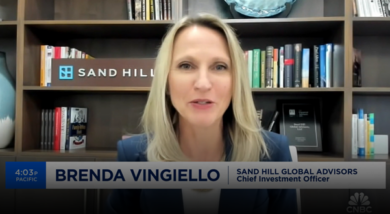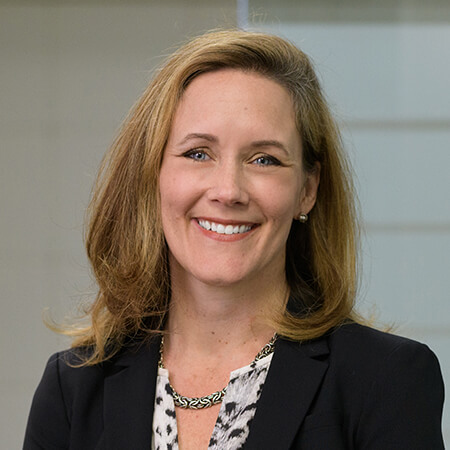Sand Hill Global Advisors Brenda Vingiello joins CNBC Last Call to share her thoughts on the current markets. This content was produced and provided by

The Charitable Lead Trust: A Vehicle Worth Considering in a Low Interest Rate Environment
Many families hold philanthropy as an important family value and strive to find ways to give efficiently, perhaps accomplishing additional objectives in the process. Investors, having lived with low interest rates for many years, are starting to see signs that rates may gradually rise. That begs a question: are there unique financial planning opportunities worth considering before rates rise? After taking advantage of basic opportunities, such as refinancing mortgages and student loans, people who are charitably inclined might be wise to explore whether a Charitable Lead Trust (CLT) would enhance their giving.
Think of Charitable Lead Trusts (CLTs) as the reverse of better-known Charitable Remainder Trusts (CRTs). CRTs provide grantors income for their lifetime, while CLTs provide that income to designated charities. Also, CRTs pay the remaining corpus of the trust to charity at the death of the Grantor while, in the case of CLTs, the corpus either goes back to the original owner or to designated beneficiaries.
CLTs come in two forms: a revocable Grantor Trust (the corpus goes back to the original owner) and irrevocable Non-Grantor Trust (the corpus goes to beneficiaries). A charitable intent is essential to the rationale to pursue either type of strategy. Capital goes into the CLT and, for a fixed term of years, payments are made to charity. But when grantors decide where the remaining corpus will go, he/she either optimizes for the charitable gift deduction or the gift tax impact of transferring assets to heirs.
For all CLTs at inception, the value of the charitable gift is calculated by summing the present value of all future charitable payments using a discount rate that is set monthly and linked to interest rates on mid-term US Treasury debt (under IRS Code Section 7520). Mathematically, this inverse relationship between interest rates and the charitable gift value results in a larger, more favorable charitable tax deduction when interest rates are low. In a Grantor Trust, because the assets will be returned to the estate of the grantor, the goal of maximizing the grantor’s charitable deduction is more easily achieved in the current interest rate environment.
Non-Grantor CLTs, irrevocable trusts that pay annual charitable contributions and distribute remaining assets to named beneficiary (ies), do not provide a frontloaded charitable tax deduction to the grantor. Instead, the focus is to minimize gift tax impacts on assets destined for beneficiaries. The value of the gift is determined at inception by subtracting the present value of the charitable payments, same as above, from the value of assets put into the trust. An added benefit is realized if, over the life of the trust, the assets contributed to the CLT appreciate on an average annual basis greater than the rate set by IRS Code 7520 (currently 2.2%) providing beneficiaries a gift worth more than the grantor claimed for gift tax purposes at the trust’s inception.
Charitable lead trusts are complex. There are many important factors that could not be addressed in this brief article. However, in this period of historically low interest rates, CLTs in either form are worth exploring for those with charitable intentions.
Articles and Commentary
Information provided in written articles are for informational purposes only and should not be considered investment advice. There is a risk of loss from investments in securities, including the risk of loss of principal. The information contained herein reflects Sand Hill Global Advisors' (“SHGA”) views as of the date of publication. Such views are subject to change at any time without notice due to changes in market or economic conditions and may not necessarily come to pass. SHGA does not provide tax or legal advice. To the extent that any material herein concerns tax or legal matters, such information is not intended to be solely relied upon nor used for the purpose of making tax and/or legal decisions without first seeking independent advice from a tax and/or legal professional. SHGA has obtained the information provided herein from various third party sources believed to be reliable but such information is not guaranteed. Certain links in this site connect to other websites maintained by third parties over whom SHGA has no control. SHGA makes no representations as to the accuracy or any other aspect of information contained in other Web Sites. Any forward looking statements or forecasts are based on assumptions and actual results are expected to vary from any such statements or forecasts. No reliance should be placed on any such statements or forecasts when making any investment decision. SHGA is not responsible for the consequences of any decisions or actions taken as a result of information provided in this presentation and does not warrant or guarantee the accuracy or completeness of this information. No part of this material may be (i) copied, photocopied, or duplicated in any form, by any means, or (ii) redistributed without the prior written consent of SHGA.
Video Presentations
All video presentations discuss certain investment products and/or securities and are being provided for informational purposes only, and should not be considered, and is not, investment, financial planning, tax or legal advice; nor is it a recommendation to buy or sell any securities. Investing in securities involves varying degrees of risk, and there can be no assurance that any specific investment will be profitable or suitable for a particular client’s financial situation or risk tolerance. Past performance is not a guarantee of future returns. Individual performance results will vary. The opinions expressed in the video reflect Sand Hill Global Advisor’s (“SHGA”) or Brenda Vingiello’s (as applicable) views as of the date of the video. Such views are subject to change at any point without notice. Any comments, opinions, or recommendations made by any host or other guest not affiliated with SHGA in this video do not necessarily reflect the views of SHGA, and non-SHGA persons appearing in this video do not fall under the supervisory purview of SHGA. You should not treat any opinion expressed by SHGA or Ms. Vingiello as a specific inducement to make a particular investment or follow a particular strategy, but only as an expression of general opinion. Nothing presented herein is or is intended to constitute investment advice, and no investment decision should be made based solely on any information provided on this video. There is a risk of loss from an investment in securities, including the risk of loss of principal. Neither SHGA nor Ms. Vingiello guarantees any specific outcome or profit. Any forward-looking statements or forecasts contained in the video are based on assumptions and actual results may vary from any such statements or forecasts. SHGA or one of its employees may have a position in the securities discussed and may purchase or sell such securities from time to time. Some of the information in this video has been obtained from third party sources. While SHGA believes such third-party information is reliable, SHGA does not guarantee its accuracy, timeliness or completeness. SHGA encourages you to consult with a professional financial advisor prior to making any investment decision.
Other Posts By This Author
- – SEP IRA or Individual 401(k)? A Question Worth Exploring for the Self-Employed
- – Donor-Advised Funds Considerations to Help Accomplish Your Philanthropic Goals
- – The Importance of Segregated Assets at Brokerage Firms
- – New EV Tax Credits Require Planning to Glean the Largest Benefits
Related Posts









